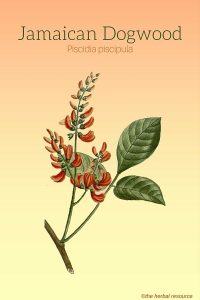Its actions are nervine, anti-spasmodic, cardiotonic, analgesic, diuretic, sedative and anodyne.
The active constituents of Jamaican dogwood are isoflavones; lisetin; jamaicin; ichthyone; the rotenoids rotenone, milletone and isomilletone; b-sitosterol; and tannins.
It contains the organic acids piscidic acid, its mono-and diethyl esters; fukiic acid and its 3-0-methyl ester.
The chemical constituents are highly variable among Jamaica dogwood trees that originate from different geographic regions.
Jamaica dogwood is well-known as a traditional remedy for treating migraine and neuralgia (severe stabbing nerve pain).
Jamaica dogwood was used for its narcotic, analgesic and sweat promoting properties as early as 1844.
It has been used primarily as an remedy for insomnia, anxiety, fear, and nervous breakdown, dysmenorrhea (painful menstruation), violent toothaches and menstrual cramps.
The bark decoction of Jamaica dogwood has been used as an herbal remedy to help relieve cough and whooping cough.
For insomnia it is best combined with hops and valerian and it may be combined with black haw as a natural treatment for dysmenorrhea.
It has been used to promote sweating, to relieve smooth muscle spasms and as a remedy to reduce fever and inflammation.
Jamaican dogwood has been used throughout Central and South America as a fish poison.
It contains a substance known as rotenone that is used in insecticides to control lice, fleas, and larvae. The component rotenone is not considered to be toxic to warm-blooded animals, including humans.
[Read more about Jamaican Dogwood…]

Leave a Reply